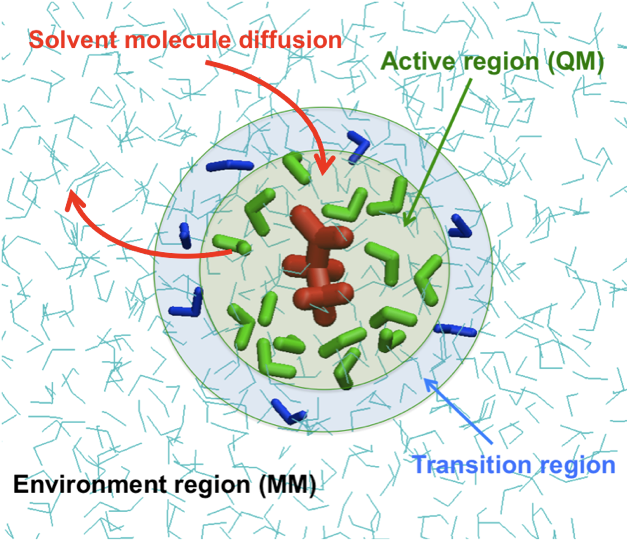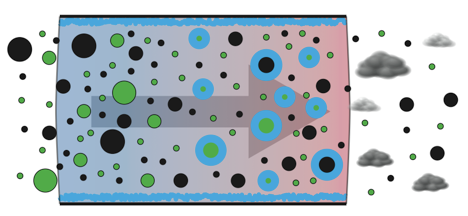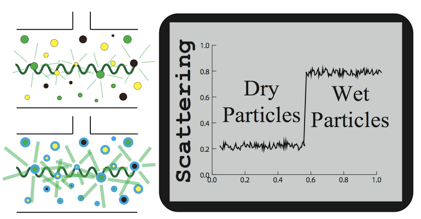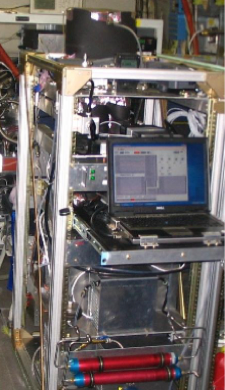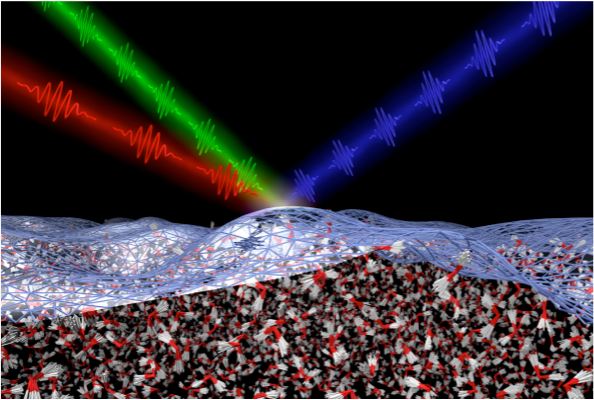Our Science
CAICE investigators perform cutting edge research on complex aerosol chemistry.
Experimentation
Computational Chemistry
Direct Dynamics Reactive Scattering-adaptive QM/MM
The reactive uptake of atmospherically-relevant gases (such as N2O5) by model aerosol surfaces will be simulated using the direct dynamics reactive scattering with adaptive quantum mechanics/molecular mechanics (DDRS-adQM/MM) approach. While the interactions of all molecules in the system would ideally be treated quantum mechanically, a fully-quantum mechanical description is often impractical due to computational expense. Alternatively, the system can be studied at a mixed quantum/classical level, where, for instance, the colliding molecule (N2O5) and the surface water molecules are treated quantum mechanically (QM) and the solvent molecules in the environment region are treated with classical molecular mechanics (MM). Contrary to conventional QM/MM methods, adQM/MM enables a fully QM representation of reactive processes in condensed phases by allowing solvent molecules to diffuse into and out of the active QM region.
Park, K., Go, A. W., Walker, R. C., & Paesani, F.,J. Chem. Theory Comput., 2012, 8(2868).
Replica Exchange Path-Integral Molecular Dynamics
A key question in atmospheric chemistry concerns the size and composition of the so-called critical cluster, the smallest cluster of molecules that will spontaneously grow by condensation (i.e., without a free-energy barrier). Quantum MD simulations will be performed in parallel with experiments to develop a comprehensive molecular-level understanding of the structural, thermodynamic, and dynamical properties of these nano-particles and to determine the molecular mechanism associated with water uptake. Replica exchange path-integral MD (RE-PIMD) will then be performed to determine, at the quantum-mechanical level, the relative stabilities and populations of the different isomeric structures as a function of temperature and chemical composition.
A key question in atmospheric chemistry concerns the size and composition of the so-called critical cluster, the smallest cluster of molecules that will spontaneously grow by condensation (i.e., without a free-energy barrier). Quantum MD simulations will be performed in parallel with experiments to develop a comprehensive molecular-level understanding of the structural, thermodynamic, and dynamical properties of these nano-particles and to determine the molecular mechanism associated with water uptake. Replica exchange path-integral MD (RE-PIMD) will then be performed to determine, at the quantum-mechanical level, the relative stabilities and populations of the different isomeric structures as a function of temperature and chemical composition.
Vibrational Spectroscopy
Molecular-level insights on the structural and dynamical properties of the interfaces will be gained from integration of spectroscopic measurements and molecular simulations. Recently, the Paesani group has developed a fully “first principles” simulation approach to model the structure, thermodynamic, dynamical, and spectroscopic properties of water under different conditions. Excellent agreement between the simulation results and the available experimental data obtained over a range of temperatures from the melting point up to near the evaporation point. In particular, the theoretically predicted energy barriers and time scales associated with the hydrogen-bond dynamics are found to be comparable to the experimental values obtained from two-dimensional and pump−probe infrared spectra.
Coarse Graining
On a molecular level, the nucleation of ice is a rare event, making its study through atomistic simulations extremely challenging. The Molinero Group has developed a computationally efficient molecular model of water (termed mW) that enables accurate simulation of ice nucleation. The coarse-grained mW model demonstrates, for example, that structural transformations of supercooled liquid water into a mostly four-coordinated liquid control the rate of homogeneous ice nucleation. This provides a microscopic foundation for the correlation between water activity and freezing rates. Recently, the mW model has been used to study homogeneous ice nucleation in aqueous salt solutions. In Phase II, these methodologies will be extended to the study of nucleation in increasingly complex systems, such as organic/water and salt/organic/water solutions and mineral surfaces.
Johnston, J. C., & Molinero, V., J Am. Chem. Soc., 2012, 134(6650)
Aerosol-Climate Measurements
Detailed simulations of global climate in the past, present, and future require precise knowledge of the role of aerosols within the radiation balance of the atmosphere. How well do they scatter light? How well do they make both liquid and ice clouds? CAICE is working to understand how chemistry can help climate scientists predict these properties.
Cloud Activity
In regions of the atmosphere is super-saturated with respect to water vapor, which particles will be seeds for liquid cloud droplets? If the composition of the particle changes, how does the cloud activity respond?
Instrument Focus: Cloud Condensation Nuclei Counter
Aerosol particles, if they are large enough and soluble enough in water, can act as the seeds for cloud droplets. These particles, called cloud condensation nuclei (or CCN), can be counted by an instrument that keeps air super-saturated with respect to water vapor (relative humidity > 100%). Once particles pass through this region of super-saturation, the ones that grew into cloud drops can be counted, while the rest pass through undetected. Comparing with an instrument that counts all particles while the composition of the aerosol is changed reveals the influence of particle chemistry on its cloud activity.
In regions of the atmosphere is super-saturated with respect to water vapor, which particles will be seeds for liquid cloud droplets? If the composition of the particle changes, how does the cloud activity respond?
Instrument Focus: Cloud Condensation Nuclei Counter
Aerosol particles, if they are large enough and soluble enough in water, can act as the seeds for cloud droplets. These particles, called cloud condensation nuclei (or CCN), can be counted by an instrument that keeps air super-saturated with respect to water vapor (relative humidity > 100%). Once particles pass through this region of super-saturation, the ones that grew into cloud drops can be counted, while the rest pass through undetected. Comparing with an instrument that counts all particles while the composition of the aerosol is changed reveals the influence of particle chemistry on its cloud activity.
Ice Nucleation Activity
Ice crystals will form ‘homogeneously’, that is, molecules of water vapor will come together and form ice crystals, only when the temperature in the atmosphere dips down to about -40 degrees Celsius. Ice clouds that form in temperatures warmer than that formed through ‘heterogeneous’ ice nucleation, where an aerosol particle provides a surface for an ice crystal germ to form.
Instrument Focus: Continuous Flow Diffusion Chamber
Perhaps the most chemically selective atmospheric process, ice crystal nucleation by particles is one of the least understood atmospheric processes in which aerosols participate. In collaboration with scientists at Colorado State University, CAICE researchers can measure the chemical contents of aerosols in parallel with the continuous flow diffusion chamber (CFDC), which subjects particles to air which is supersaturated with water vapor (like the CCN counter above), but at temperatures down to -40 degrees Celsius. We can also perform single droplet freezing studies on these particles to learn more about the location of ice nucleation on aerosols to direct our further studies of the impact of aerosol particle composition and morphology on the formation of ice in clouds. The goal is to derive a fundamental understanding of the chemical and/or morphological controls on heterogeneous ice nucleation.
Ice crystals will form ‘homogeneously’, that is, molecules of water vapor will come together and form ice crystals, only when the temperature in the atmosphere dips down to about -40 degrees Celsius. Ice clouds that form in temperatures warmer than that formed through ‘heterogeneous’ ice nucleation, where an aerosol particle provides a surface for an ice crystal germ to form.
Instrument Focus: Continuous Flow Diffusion Chamber
Perhaps the most chemically selective atmospheric process, ice crystal nucleation by particles is one of the least understood atmospheric processes in which aerosols participate. In collaboration with scientists at Colorado State University, CAICE researchers can measure the chemical contents of aerosols in parallel with the continuous flow diffusion chamber (CFDC), which subjects particles to air which is supersaturated with water vapor (like the CCN counter above), but at temperatures down to -40 degrees Celsius. We can also perform single droplet freezing studies on these particles to learn more about the location of ice nucleation on aerosols to direct our further studies of the impact of aerosol particle composition and morphology on the formation of ice in clouds. The goal is to derive a fundamental understanding of the chemical and/or morphological controls on heterogeneous ice nucleation.
Interface Selective Experimentation
Sum Frequency Generation Spectroscopy
Sum frequency generation (SFG) is a type of vibrational spectroscopy in which infrared and visible laser pulses are overlapped in time and space at an interface. Unlike most spectroscopic techniques, SFG provides information exclusively about the chemistry of interfaces, which allows us to study the surfaces of SSA particles, without contributions from the bulk. Probing the surface through C-H bond vibrations allows for an understanding of the surface orientation of organic molecules, while probing O-H vibrations provides information about the structure of water at the gas-liquid interface and its interactions with solutes and thin organic films.
Gas-Liquid Molecular Beam Scattering
In order to understand the fundamental physical chemistry of reactions at complex environmental interfaces, the Nathanson Research Group will use a gas-liquid molecular beam scattering technique. This apparatus directs a beam of gaseous reagent molecules at a liquid surface, inducing a chemical reaction at the gas-liquid interface. A mass spectrometer is used to determine the identity and quantity of the product gases. These studies will complement heterogeneous chemistry studies performed by the Bertram (experimental) and Paesani (computational) research groups.

